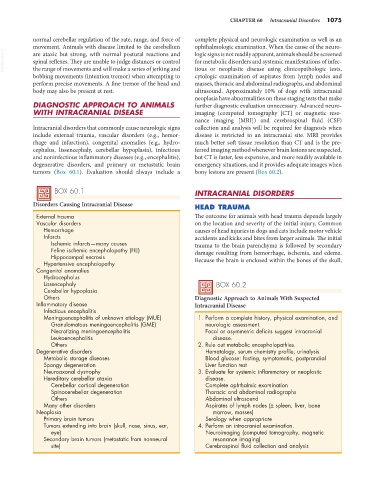Page 1103 - Small Animal Internal Medicine, 6th Edition
P. 1103
CHAPTER 60 Intracranial Disorders 1075
normal cerebellar regulation of the rate, range, and force of complete physical and neurologic examination as well as an
movement. Animals with disease limited to the cerebellum ophthalmologic examination. When the cause of the neuro-
VetBooks.ir are ataxic but strong, with normal postural reactions and logic signs is not readily apparent, animals should be screened
for metabolic disorders and systemic manifestations of infec-
spinal reflexes. They are unable to judge distances or control
the range of movements and will make a series of jerking and
cytologic examination of aspirates from lymph nodes and
bobbing movements (intention tremor) when attempting to tious or neoplastic disease using clinicopathologic tests,
perform precise movements. A fine tremor of the head and masses, thoracic and abdominal radiographs, and abdominal
body may also be present at rest. ultrasound. Approximately 10% of dogs with intracranial
neoplasia have abnormalities on these staging tests that make
DIAGNOSTIC APPROACH TO ANIMALS further diagnostic evaluation unnecessary. Advanced neuro-
WITH INTRACRANIAL DISEASE imaging (computed tomography [CT] or magnetic reso-
nance imaging [MRI]) and cerebrospinal fluid (CSF)
Intracranial disorders that commonly cause neurologic signs collection and analysis will be required for diagnosis when
include external trauma, vascular disorders (e.g., hemor- disease is restricted to an intracranial site. MRI provides
rhage and infarction), congenital anomalies (e.g., hydro- much better soft tissue resolution than CT and is the pre-
cephalus, lissencephaly, cerebellar hypoplasia), infectious ferred imaging method whenever brain lesions are suspected,
and noninfectious inflammatory diseases (e.g., encephalitis), but CT is faster, less expensive, and more readily available in
degenerative disorders, and primary or metastatic brain emergency situations, and it provides adequate images when
tumors (Box 60.1). Evaluation should always include a bony lesions are present (Box 60.2).
BOX 60.1 INTRACRANIAL DISORDERS
Disorders Causing Intracranial Disease
HEAD TRAUMA
External trauma The outcome for animals with head trauma depends largely
Vascular disorders on the location and severity of the initial injury. Common
Hemorrhage causes of head injuries in dogs and cats include motor vehicle
Infarcts accidents and kicks and bites from larger animals. The initial
Ischemic infarcts—many causes trauma to the brain parenchyma is followed by secondary
Feline ischemic encephalopathy (FIE) damage resulting from hemorrhage, ischemia, and edema.
Hippocampal necrosis
Hypertensive encephalopathy Because the brain is enclosed within the bones of the skull,
Congenital anomalies
Hydrocephalus
Lissencephaly BOX 60.2
Cerebellar hypoplasia
Others Diagnostic Approach to Animals With Suspected
Inflammatory disease Intracranial Disease
Infectious encephalitis
Meningoencephalitis of unknown etiology (MUE) 1. Perform a complete history, physical examination, and
Granulomatous meningoencephalitis (GME) neurologic assessment.
Necrotizing meningoencephalitis Focal or asymmetric deficits suggest intracranial
Leukoencephalitis disease.
Others 2. Rule out metabolic encephalopathies.
Degenerative disorders Hematology, serum chemistry profile, urinalysis
Metabolic storage diseases Blood glucose: fasting, symptomatic, postprandial
Spongy degeneration Liver function test
Neuroaxonal dystrophy 3. Evaluate for systemic inflammatory or neoplastic
Hereditary cerebellar ataxia disease.
Cerebellar cortical degeneration Complete ophthalmic examination
Spinocerebellar degeneration Thoracic and abdominal radiographs
Others Abdominal ultrasound
Many other disorders Aspirates of lymph nodes (± spleen, liver, bone
Neoplasia marrow, masses)
Primary brain tumors Serology when appropriate
Tumors extending into brain (skull, nose, sinus, ear, 4. Perform an intracranial examination.
eye) Neuroimaging (computed tomography, magnetic
Secondary brain tumors (metastatic from nonneural resonance imaging)
site) Cerebrospinal fluid collection and analysis

